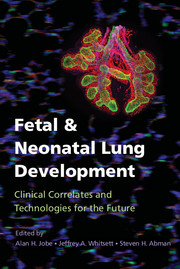Book contents
- Fetal and Neonatal Lung Development
- Lung Growth, Development, and Disease
- Fetal and Neonatal Lung Development
- Copyright page
- Contents
- Contributors
- Preface
- Chapter 1 The Genetic Programs Regulating Embryonic Lung Development and Induced Pluripotent Stem Cell Differentiation
- Chapter 2 Early Development of the Mammalian Lung-Branching Morphogenesis
- Chapter 3 Pulmonary Vascular Development
- Chapter 4 Transcriptional Mechanisms Regulating Pulmonary Epithelial Maturation:
- Chapter 5 Environmental Effects on Lung Morphogenesis and Function:
- Chapter 6 Congenital Malformations of the Lung
- Chapter 7 Lung Structure at Preterm and Term Birth
- Chapter 8 Surfactant During Lung Development
- Chapter 9 Initiation of Breathing at Birth
- Chapter 10 Perinatal Modifiers of Lung Structure and Function
- Chapter 11 Chronic Neonatal Lung Injury and Care Strategies to Decrease Injury
- Chapter 12 Apnea and Control of Breathing
- Chapter 13 Alveolarization into Adulthood
- Chapter 14 Physiologic Assessment of Lung Growth and Development Throughout Infancy and Childhood
- Chapter 15 Perinatal Disruptions of Lung Development:
- Chapter 16 Lung Growth Through the “Life Course” and Predictors and Determinants of Chronic Respiratory Disorders
- Chapter 17 The Lung Structure Maintenance Program: Sustaining Lung Structure during Adulthood and Implications for COPD Risk
- Index
- References
Chapter 9 - Initiation of Breathing at Birth
Published online by Cambridge University Press: 05 April 2016
- Fetal and Neonatal Lung Development
- Lung Growth, Development, and Disease
- Fetal and Neonatal Lung Development
- Copyright page
- Contents
- Contributors
- Preface
- Chapter 1 The Genetic Programs Regulating Embryonic Lung Development and Induced Pluripotent Stem Cell Differentiation
- Chapter 2 Early Development of the Mammalian Lung-Branching Morphogenesis
- Chapter 3 Pulmonary Vascular Development
- Chapter 4 Transcriptional Mechanisms Regulating Pulmonary Epithelial Maturation:
- Chapter 5 Environmental Effects on Lung Morphogenesis and Function:
- Chapter 6 Congenital Malformations of the Lung
- Chapter 7 Lung Structure at Preterm and Term Birth
- Chapter 8 Surfactant During Lung Development
- Chapter 9 Initiation of Breathing at Birth
- Chapter 10 Perinatal Modifiers of Lung Structure and Function
- Chapter 11 Chronic Neonatal Lung Injury and Care Strategies to Decrease Injury
- Chapter 12 Apnea and Control of Breathing
- Chapter 13 Alveolarization into Adulthood
- Chapter 14 Physiologic Assessment of Lung Growth and Development Throughout Infancy and Childhood
- Chapter 15 Perinatal Disruptions of Lung Development:
- Chapter 16 Lung Growth Through the “Life Course” and Predictors and Determinants of Chronic Respiratory Disorders
- Chapter 17 The Lung Structure Maintenance Program: Sustaining Lung Structure during Adulthood and Implications for COPD Risk
- Index
- References
Summary
Recent animal and human studies have challenged some of the prevailing concepts regarding the major physiological changes that characterize the transition to life after birth. In this chapter we will explain in detail how the breathing effort initiates a pulmonary and hemodynamic cascade of events that is of vital importance for survival after birth. The role of cord clamping and its effects on the hemodynamic transition will be discussed. This chapter also covers the pathophysiology of preterm infants failing transition and the current strategies caregivers can use to support them. Finally, we describe how positive pressure ventilation (PPV) can cause not only lung injury, but can also adversely affect cardiovascular function and initiate a systemic inflammatory cascade that can injure the immature brain.
- Type
- Chapter
- Information
- Fetal and Neonatal Lung DevelopmentClinical Correlates and Technologies for the Future, pp. 164 - 186Publisher: Cambridge University PressPrint publication year: 2016
References
Reference List
- 2
- Cited by



